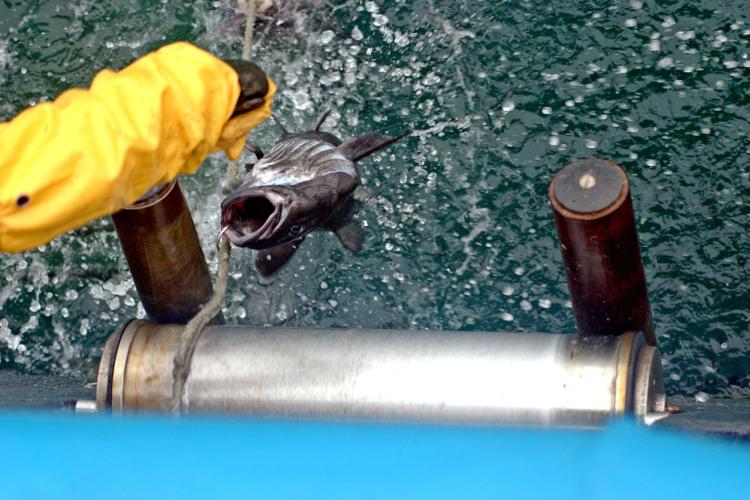
Grant Voirol removes the otoliths from a young sablefish.
So how does longlining work? I wasn’t sure myself before I got on the boat other than guessing that there was probably a line and it was probably pretty long. Turns out I was right.
The line used is miles long and sectioned into groups of hooks called “skates.” In each skate there are 45 hooks and on each line there are 80 skates. Every day we pull in two lines or “sets.” That’s over 7,000 hooks every day. Phew! Between each skate is a weight, called “the ball,” which helps bring the line to the seafloor evenly where we want our hooks to be.
The fishermen set out the gear early in the morning, between 5 and 6 o’clock (thankfully before I get up).Breakfast is at 8 and then we begin hauling the gear back at around 9:30. The fishermen haul up the buoys that mark where the line begins and feed the line through machinery that pull it in. As the line comes in, two fishermen stand “at the rail” where the line comes over the side and into the boat. Using a gaff, basically a long hook, one of the fishermen helps the fish caught on the line get over the roller on the side of the boat so they don’t fall off. Another fisherman is ready with a net to catch any that do. Once on the boat, the hooks are removed from the fish and the fish are sent through the inside of the boat to the factory to be processed and frozen.

A tub of groundline with two skates of gear.
My job is to take otoliths from select sablefish and to tag and release any sablefish, shortspine thornyhead, or Greenland turbot that come up on one of the designated “tag skates.” Otoliths are small ear bones in the head of the fish that grow layer upon layer, similar to tree rings. By studying the number of rings in the otoliths, we can get an accurate age of the fish. This information is important for stock assessment scientists who utilize fish ages in models that calculate abundance and forecast population changes.
So far it’s been smooth sailing (literally) and the number of sablefish for me to sample have not been overwhelming. When things are slow, I can go back to the factory and help pass fish to another scientist taking lengths or go up on deck and watch the scenery and see what is coming up on the line. Right now things are calm but I heard from the captain that we are in for some rough weather ahead. Time for some seasickness medication.



